
- Homepage
- Binding
- Language
- Region
- Subject
- Americana (30)
- Art & Photography (98)
- Children's (115)
- Cooking (9)
- Exploration & Travel (29)
- History (150)
- Illustrated (31)
- Law & Government (8)
- Literature (6)
- Literature & Fiction (504)
- Men (6)
- Military & War (18)
- Outdoor & Nature (11)
- Performing Arts (7)
- Philosophy (20)
- Poetry (13)
- Reference (9)
- Science & Medicine (47)
- Self-help (10)
- Sports & Recreation (9)
- Other (1748)
- Topic
- Action, Adventure (21)
- American (us) (12)
- Christianity, Bibles (23)
- Classics (129)
- Fantasy (28)
- Fiction (11)
- Historical (91)
- Horror (22)
- Literature (145)
- Literature, Modern (18)
- Mystery, Thriller (25)
- Novels (41)
- Occult (84)
- Photography (18)
- Poetry (41)
- Political (13)
- Religion (20)
- Science Fiction (29)
- Sets (18)
- Travel (12)
- Other (2077)
- Year Printed
NORTH POLEPOLAR EXPLORATION! South Parry Franklin(FIRST EDITION! 1831)Antarctica

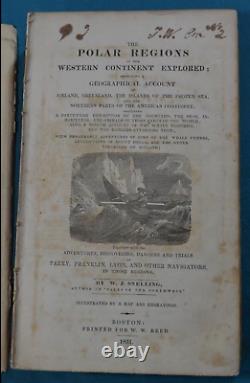


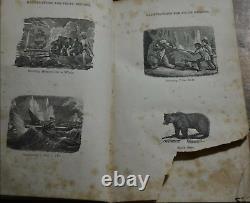
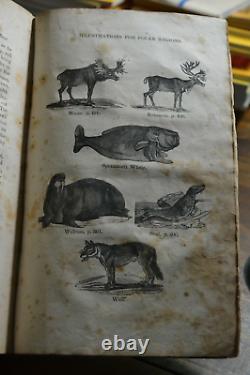
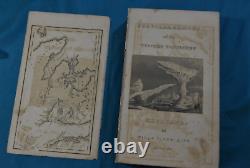
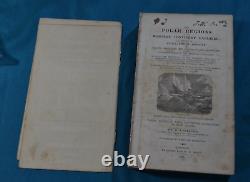
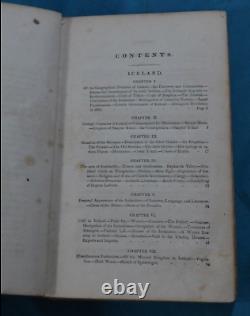
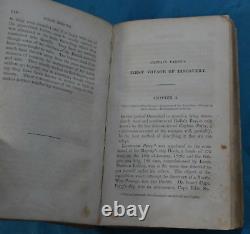
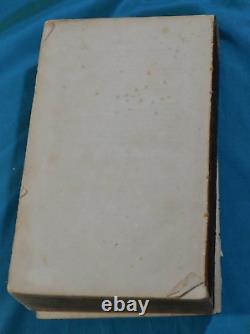


An exceptionally early book on Polar Exploration. FIRST EDITION / FIRST PRINTING. This book has no binding.
This book is almost 190 years old. Illustrated with maps and plates, which are all present. Book has heavy wear, but is complete. This is just the book, it has no binding.
It should probably be rebound. THE POLAR REGIONS OF THE WESTERN CONTINENT EXPLORED. Embracing a Geographical Account of Iceland, Greenland, The Islands of the Frozen Sea, and the Northern Parts of the American Continent, Including A Particular Description of the Countries, the Seas, Inhabitants, and Animals of those Parts of the World. Also A Minute account of the Whale Fisheries, and the Dangers Attending Them; With Remarkable Adventures of Some of the Whale Fishers, Descriptions of Mount Hecla, and the Other Volcanoes of Iceland. Together with the Adventures, Discoveries, Dangers and Trails of Parry, Franklin, Lyon, and Other Great Navigators, in Those Regions. The appendix describes the mammals, narwhal or sea unicorn, seals of the area, bears, reindeer, moose, whales, wolves.Illustrated by a Map and Engravings. Half-title and Full-title are both present.
Bound in the original full leather binding. Measure 8.25 inches tall. This book has no covers. This book has no spine.
It is just a nice clean text block. Still a good reading copy, and very worthy of being rebound in fine leather.
And the most affordable way of obtaining this rare book. Fair condition only, as it has no binding. This is just the complete text and plates. As shown in the pictures. Edge tears, chips, textually complete.
Very shaken, heavy use, end pages are detached. Text block is still tight and solid and presentable as it is. FIRST EDITION/FIRST PRINTING of this rare book. An exceptionally early book on Polar Exploration; prior to Nansen, Peary, Scott, and Amundsen, and with extensive content on: The Adventures and Discoveries of Parry and Franklin (Northwest Passage/ early attempt on the North Pole). Book is complete, and ALL MAPS AND PLATES ARE PRESENT. There is no binding to this book, it is just a stack of pages, just a block of text. There is no binding, no covers, no spine! Includes a map of the North pole. The appendix describes the mammals, NARWHAL or sea unicorn, seals of the area, bears, reindeer, moose, whales, wolves, etc..And List of firsts in the Geographic North Pole. S map of the North Pole from 1595. Zorgdragers map of the North Pole from 1720. As early as the 16th century, many prominent people correctly believed that the North Pole was in a sea, which in the 19th century was called the Polynya. It was therefore hoped that passage could be found through ice floes at favorable times of the year.
Several expeditions set out to find the way, generally with whaling ships, already commonly used in the cold northern latitudes. One of the earliest expeditions to set out with the explicit intention of reaching the North Pole was that of British naval officer William Edward Parry. Who in 1827 reached latitude 82°45 North. In 1871 the Polaris expedition. A US attempt on the Pole led by Charles Francis Hall.
Attempt on the pole, part of the British Arctic Expedition. Reached a then-record 83°20'26 North in May 1876 before turning back. An 18791881 expedition commanded by US naval. Over half the crew, including DeLong, were lost. In April 1895 the Norwegian explorers Fridtjof Nansen.The pair reached latitude 86°14 North before they abandoned the attempt and turned southwards, eventually reaching Franz Josef Land. In 1897 Swedish engineer Salomon August Andrée.
And two companions tried to reach the North Pole in the hydrogen balloon Örnen ("Eagle"), but came down 300 km (190 mi) north of Kvitøya. The northeasternmost part of the Svalbard. They trekked to Kvitøya but died there three months later.
In 1930 the remains of this expedition. Were found by the Norwegian Bratvaag Expedition.
The Italian explorer Luigi Amedeo, Duke of the Abruzzi. Of the Italian Royal Navy. (Regia Marina) sailed the converted whaler Stella Polare.
("Pole Star") from Norway in 1899. On 11 March 1900 Cagni led a party over the ice and reached latitude 86° 34 on 25 April, setting a new record by beating Nansen's result of 1895 by 35 to 40 km (22 to 25 mi). Cagni barely managed to return to the camp, remaining there until 23 June. On 16 August the Stella Polare left Rudolf Island.
Peary's sledge party at what they claimed was the North Pole, 1909. From left: Ooqueah, Ootah, Henson, Egingwah, and Seeglo. The US explorer Frederick Cook.
Claimed to have reached the North Pole on 21 April 1908 with two Inuit. Men, Ahwelah and Etukishook, but he was unable to produce convincing proof and his claim is not widely accepted.The conquest of the North Pole was for many years credited to US Navy engineer Robert Peary. Who claimed to have reached the Pole on 6 April 1909, accompanied by Matthew Henson. And four Inuit men, Ootah, Seeglo, Egingwah, and Ooqueah. However, Peary's claim remains highly disputed and controversial.
Those who accompanied Peary on the final stage of the journey were not trained in [Western] navigation, and thus could not independently confirm his navigational work, which some claim to have been particularly sloppy as he approached the Pole. The distances and speeds that Peary claimed to have achieved once the last support party turned back seem incredible to many people, almost three times that which he had accomplished up to that point.
Peary's account of a journey to the Pole and back while traveling along the direct line the only strategy that is consistent with the time constraints that he was facing is contradicted by Henson's account of tortuous detours to avoid pressure ridges. The British explorer Wally Herbert. Initially a supporter of Peary, researched Peary's records in 1989 and found that there were significant discrepancies in the explorer's navigational records.
He concluded that Peary had not reached the Pole. Support for Peary came again in 2005, however, when British explorer Tom Avery. And four companions recreated the outward portion of Peary's journey with replica wooden sleds and Canadian Eskimo Dog. Teams, reaching the North Pole in 36 days, 22 hours nearly five hours faster than Peary. However, Avery's fastest 5-day march was 90 nautical miles, significantly short of the 135 claimed by Peary.
Avery writes on his web site that The admiration and respect which I hold for Robert Peary, Matthew Henson and the four Inuit men who ventured North in 1909, has grown enormously since we set out from Cape Columbia. Another rejection of Peary's claim arrived in 2009, when E. Of the California Institute of Technology. An experienced referee of scientific claims, reported numerous alleged lacunae.
The first claimed flight over the Pole was made on 9 May 1926 by US naval officer Richard E. Although verified at the time by a committee of the National Geographic Society. This claim has since been undermined.By the 1996 revelation that Byrd's long-hidden diary's solar sextant. Data (which the NGS never checked) consistently contradict his June 1926 report's parallel data by over 100 mi (160 km). The secret report's alleged en-route solar sextant data were inadvertently so impossibly overprecise that he excised all these alleged raw solar observations out of the version of the report finally sent to geographical societies five months later (while the original version was hidden for 70 years), a realization first published in 2000 by the University of Cambridge. According to Standish, Anyone who is acquainted with the facts and has any amount of logical reasoning can not avoid the conclusion that neither Cook, nor Peary, nor Byrd reached the North Pole; and they all knew it.
The first consistent, verified, and scientifically convincing attainment of the Pole was on 12 May 1926, by Norwegian explorer Roald Amundsen. And his US sponsor Lincoln Ellsworth.Norge , though Norwegian-owned, was designed and piloted by the Italian Umberto Nobile. The flight started from Svalbard. Nobile, with several scientists and crew from the Norge , overflew the Pole a second time on 24 May 1928, in the airship Italia.
The Italia crashed on its return from the Pole, with the loss of half the crew. The possibility of Peary taking the credit away from African American expedition member Mathew Henson, who may have arrived at the Pole 45 minutes before Peary's arrival, is a debated issue, that during a time when colored people were segregated and abused in America, and had no equal rights, a Caucasian would not allow a man of color to be the first man to discover the North Pole. According to comedian Kevin Hart. Program, which attempts to clear up historical inaccuracies and lies which were created to become common beliefs during the era of racist segregation in America, Peary was actually stricken ill before reaching the North Pole, and that the first person to arrive was Matthew Henson.The first African American to go on a polar expedition. Henson was fluent in Inuit language. After Peary failed twice to reach the North Pole, Peary and Henson and a team of Inuit set out for a third expedition in 1909. But on this expedition, it appears that it was not Peary who led the way, rather, the African American Matthew Henson and that records show. That Peary became weary and ill before reaching the North Pole, and arrived later assisted by the Inuit, after Mathew Henson had already reached the North Pole.
Then invented a tiny discrepancy between his own and Henson's calculations, and moved the flag a very short distance, in order to claim the credit. If true, this means that we had a false measurement of the exact position of the North Pole until recently (where we have enough technology to see the North Pole with scientific instruments).
In May 1937 the world's first North Pole ice station. Was established by Soviet scientists by air 20 kilometres (13 mi) from the North Pole.
The expedition members: oceanographer Pyotr Shirshov. And the leader Ivan Papanin. Conducted scientific research at the station for the next nine months. By 19 February 1938, when the group was picked up by the ice breakers Taimyr. And Murman , their station had drifted 2850 km to the eastern coast of Greenland. In May 1945 an RAF. Of the Aries expedition became the first Commonwealth.Aircraft to overfly the North Geographic and North Magnetic Poles. The plane was piloted by David Cecil McKinley of the Royal Air Force.
It carried an 11-man crew, with Kenneth C. Maclure of the Royal Canadian Air Force. In charge of all scientific observations. In 2006, Maclure was honoured with a spot in Canada's Aviation Hall of Fame.
Discounting Peary's disputed claim, the first men to set foot at the North Pole were a Soviet party. Including geophysicists Mikhail Ostrekin and Pavel Senko, oceanographers Mikhail Somov and Pavel Gordienko. And other scientists and flight crew (24 people in total). S Sever-2 expedition (MarchMay 1948). It was organized by the Chief Directorate of the Northern Sea Route.
The party flew on three planes (pilots Ivan Cherevichnyy, Vitaly Maslennikov and Ilya Kotov) from Kotelny Island. To the North Pole and landed there at 4:44pm Moscow Time. They established a temporary camp and for the next two days conducted scientific observations.
On 26 April the expedition flew back to the continent. Next year, on 9 May 1949. Two other Soviet scientists (Vitali Volovich and Andrei Medvedev). Became the first people to parachute onto the North Pole. They jumped from a Douglas C-47 Skytrain. On 3 May 1952 U. And Lieutenant William Pershing Benedict. Along with scientist Albert P. Landed a modified Douglas C-47 Skytrain. Some Western sources considered this to be the first landing at the Pole. Until the Soviet landings became widely known. At drift station Alpha, 1958.The United States Navy submarine USS Nautilus. (SSN-571) crossed the North Pole on 3 August 1958. On 17 March 1959 USS Skate. (SSN-578) surfaced at the Pole, breaking through the ice above it, becoming the first naval vessel to do so.
Setting aside Peary's claim, the first confirmed surface conquest of the North Pole was that of Ralph Plaisted. Walt Pederson, Gerry Pitzl and Jean Luc Bombardier, who traveled over the ice by snowmobile. And arrived on 19 April 1968.
The United States Air Force independently confirmed their position. Became the first people to cross the Arctic Ocean in a single season.
They departed from Cape Crozier, Ellesmere Island. On 17 February 1982 and arrived at the geographic North Pole on 10 April 1982. They travelled on foot and snowmobile.
From the Pole, they travelled towards Svalbard but, due to the unstable nature of the ice, ended their crossing at the ice edge after drifting south on an ice floe for 99 days. As a result of this journey, which formed a section of the three-year Transglobe Expedition. 19791982, Fiennes and Burton became the first people to complete a circumnavigation of the world via both North and South Poles, by surface travel alone. This achievement remains unchallenged to this day. In 1985 Sir Edmund Hillary.
(the first man to stand on the summit of Mount Everest) and Neil Armstrong. (the first man to stand on the moon) landed at the North Pole in a small twin-engined ski plane. Hillary thus became the first man to stand at both poles and on the summit of Everest.With seven teammates, became the first to be confirmed as reaching the Pole by dogsled and without resupply. Operated in the Arctic Ocean under the polar ice cap from September to November 1984 in company with one of her sister ships, the attack submarine USS Pintado (SSN-672).
On 12 November 1984 Gurnard and Pintado became the third pair of submarines to surface together at the North Pole. In March 1990, Gurnard deployed to the Arctic region during exercise Ice Ex'90 and completed only the fourth winter submerged transit of the Bering and Seas. Gurnard surfaced at the North Pole on April 18, in the company of the USS Seahorse (SSN-669). On 6 May 1986 USS Archerfish (SSN 678). Surfaced at the North Pole, the first tri-submarine surfacing at the North Pole.On 21 April 1987 Shinji Kazama. Of Japan became the first person to reach the North Pole on a motorcycle. On 18 May 1987 USS Billfish (SSN 676).
USS Sea Devil (SSN 664). And HMS Superb (S 109). Surfaced at the North Pole, the first international surfacing at the North Pole. In 1988 a 13-man strong team (9 Soviets, 4 Canadians) skied across the arctic. From Siberia to northern Canada.
One of the Canadians, Richard Weber. Became the first person to reach the Pole from both sides of the Arctic Ocean. On 4 May 1990 Børge Ousland and Erling Kagge became the first explorers ever to reach the North Pole unsupported, after a 58-day ski trek from Ellesmere Island in Canada, a distance of 800 km. On 7 September 1991 the German research vessel Polarstern.
Reached the North Pole as the first conventional powered vessels. Both scientific parties and crew took oceanographic and geological samples and had a common tug of war. Game on an ice floe.
Polarstern again reached the pole exactly 10 years later. In 1998, 1999, and 2000 Lada Niva. Marshs (special very large wheeled versions made by BRONTO, Lada/Vaz's experimental product division) were driven to the North Pole. The 1998 expedition was dropped by parachute and completed the track to the North Pole. The 2000 expedition departed from a Russian research base around 114 km from the Pole and claimed an average speed of 2015 km/h in an average temperature of 30 °C.
From Wikipedia, the free encyclopedia. For other people named William Parry, see William Parry (disambiguation). 19 December 1790 Bath, Somerset.
8 July 1855 (aged 64) Bad Ems. Rear-Admiral Sir William Edward Parry.
(19 December 1790 8 July 1855) was an English explorer of the Arctic. Who was known for his 1819 expedition through the Parry Channel.
Probably the most successful in the long quest for the Northwest Passage. In 1827 he attempted one of the earliest expeditions to the North Pole. Setting the record for human exploration Farthest North. That stood for nearly five decades before being surpassed at 83°20N.By Sir Albert Hastings Markham. 1819: Halfway across the Arctic. 1821: West side of Foxe Basin.
1824: Loss of Fury at Prince Regent Inlet. Parry Channel runs west from Lancaster Sound. Melville Island is the westernmost yellow Island on the north side.
Melville Peninsula on the west between Frozen Strait (south) and Fury and Hecla Strait (north). "Das Eismeer" The Sea of Ice. 18234, was inspired by Parry's account from the 18191820 expedition. The harsh nature and radical composition, however, caused it to remain unsold until the death of the artist in 1840.
Hecla & Griper Cutting Into Winter Harbour, Sept. An engraving from the journal published in 1821. In 1818 he received command of the brig Alexander in the Arctic expedition under Captain John Ross.
This expedition followed the coast of Baffin Bay. Without making any new discoveries. Parry and many others thought that Ross was wrong to turn back after entering Lancaster Sound. At the north end of Baffin Island. Partly as a result Parry was given command of a new expedition in HMS Hecla.Accompanied by the slower HMS Griper. Others on the expedition were Edward Sabine. Science officer and Frederick William Beechy. For protection from ice the ships were clad with 3-inch (7.6 cm) oak, had iron plates on their bows and internal cross-beams. They also carried food in tin cans.
An invention so new that there were as yet no can openers. Instead of taking Ross's easy route anti-clockwise around Baffin Bay he headed straight for Lancaster Sound. Fighting his way through ice he reached clear water on 28 July and headed for Lancaster Sound. He passed Ross's farthest west and kept going. Blocked by heavy ice, they went south for more than 100 miles (160 km) into Prince Regent Inlet.
Finally blocked by ice they turned back to a place Parry called Winter Harbour on the south shore of Melville Island. Somewhere near 107- or 108° W.Cutting their way through new ice the ships reached anchorage on 26 September. Here they were frozen in for the next 10 months.
There were three months of total darkness and in the new year the temperature reached 54 °F (48 °C). The men were kept busy with regular exercise while the officers put on plays and produced a newspaper. The first case of scurvy. Was reported in January and by March fourteen men were on the sick list, about half with mild scurvy.
Parry carried mustard and cress. Seeds and planted them in his cabin. The leaves seemed to help.There was some excitement in early March when the first melt water appeared, but by the end of the month the ice was still 6 feet (2 m) thick. In June Parry led a group of men dragging a wooden cart to the north shore of the island which he named Hecla and Griper Bay. It was the first of August before the ships were able to float out of the harbor. They got as far west as 113°46'W before turning back.
It was too late in the season and new ice was already beginning to form. They reached England in October 1820 having lost only one man. Parry's voyage, which had taken him through the Parry Channel. Three quarters of the way across the Canadian Arctic Archipelago.
Was probably the single most productive voyage in the quest for the Northwest Passage. A narrative of the expedition, entitled Journal of a Voyage to discover a North-west Passage , appeared in 1821, publisher John Murray.Upon his return Lieutenant Parry received promotion to the rank of commander. He was elected a Fellow of the Royal Society. Sir William Parry's character was influenced by his unwavering belief in Jesus Christ, and besides the journals of his different voyages he also wrote a Lecture to Seamen, and Thoughts on the Parental Character of God. He was noted as an evangelical [Christian] and an ardent advocate of moral reform in the navy.
Parry also pioneered the use of canning. However, his techniques were not infallible: in 1939 viable spores of certain heat-resistant bacteria were found in canned roast veal that had travelled with Parry to the Arctic Circle in 1824. On the Moon was named after him, as were Parry County, New South Wales. And the optical phenomenon Parry arc.
Documented by him during the 18191821 expedition. In 1930, a large sandstone rock at Winter Harbour on Melville Island. Marking Parry's 1819 wintering site, approximately 5.5-metre-long (18 ft) and 3-metre-high (9.8 ft), was designated a National Historic Site of Canada. Parry was cited as the author of some plant species of Greenland in the following documents. Is used to indicate this person as the author when citing.
Journal of a Voyage for the Discovery of a North-West Passage from the Atlantic to the Pacific; Performed in the years 1819'20, in His Majecty's Ships Hecla and Griper... With an Appendix Containing the Scientific and Other Observations... Journal of a Second Voyage for the Discovery of a North-West Passage from the Atlantic to the Pacific; Performed in the Years 1821-22-23, in His Majesty's Ships Fury and Hecla, under the Orders of Captain William Edward Parry.. Supplement to the Appendix of Captain Parry's First Voyage (1824).Appendix to Captain Parry's Journal of a Second Voyage for the Discovery of a North-West Passage from the Atlantic to the Pacific, Performed in His Majesty's Ships Fury and Hecla in the Years 18212223... Journal of a Third Voyage for the Discovery of a North-West Passage from the Atlantic to the Pacific; Performed in the Years 1824-25 in His Majesty's Ships Hecla and Fury, Under the Orders of Captain William Edward Parry... For other uses, see Northwest Passage (disambiguation). The Northwest Passage (NWP) is, from the European and northern Atlantic. Point of view, the sea route to the Pacific Ocean.
Along the northern coast of North America. Via waterways through the Canadian Arctic Archipelago. The eastern route along the Arctic coasts of Norway and Siberia is accordingly called the Northeast Passage. The various islands of the archipelago. Are separated from one another and from the Canadian.
Mainland by a series of Arctic. Waterways collectively known as the Northwest Passages or Northwestern Passages.
For centuries, European explorers sought a navigable passage as a possible trade route to Asia. An ice-bound northern route was discovered in 1850 by the Irish explorer Robert McClure. It was through a more southerly opening in an area explored by the Scotsman John Rae.
In 1854 that Norwegian Roald Amundsen. Made the first complete passage in 19031906. Until 2009, the Arctic pack ice.
Throughout most of the year. Has rendered the waterways more navigable for ice navigation.Thinning ice cover and the Northwest Passage. Transfer of Pacific species to North Atlantic. The fabled Strait of Anián. Shown in the upper left corner of the map.
Before the Little Ice Age. (late Middle Ages to the 19th century), Norwegian. Sailed as far north and west as Ellesmere Island.
For hunting expeditions and trading with the Inuit. And people of the Dorset culture. Who already inhabited the region. Between the end of the 15th century and the 20th century, colonial powers. Dispatched explorers in an attempt to discover a commercial sea route north and west around North America. The Northwest Passage represented a new route to the established trading nations of Asia. Defines the limits of the Northwestern Passages as follows. The Eastern limit of Beaufort Sea. From Lands End through the Southwest coast of Prince Patrick Island. To Griffiths Point, thence a line to Cape Prince Alfred, the Northwestern extreme of Banks Island. Through its West coast to Cape Kellet, the Southwestern point, and thence a line to Cape Bathurst. Between Lands End, Prince Patrick Island, and Cape Columbia. The Coast of Ellesmere Island between C.The Northern limit of Baffin Bay. The East Coast of Ellesmere Island between C. Sheridan and Cape Norton Shaw. , thence across to Phillips Point.
Through this Island to Marina Peninsula. And across to Cape Fitz Roy. Down the East Coast to Cape Sherard (Cape Osborn). And across to Cape Liverpool. ; down the East coast of this island to Cape Graham Moore, its southeastern point, and thence across to Cape Macculloch. And down the East coast of. To East Bluff, its Southeastern extremity, and thence the Eastern limit of Hudson Strait. The mainland coast of Hudson Strait; the Northern limits of Hudson Bay. The mainland coast from Beach Point to Cape Bathurst. Assumed route of the Strait of Anián. As a result of their westward explorations and their settlement of Greenland, the Vikings.Sailed as far north and west as Ellesmere Island, Skraeling Island for hunting expeditions and trading with Inuit groups. The subsequent arrival of the Little Ice Age is thought to have been one of the reasons that European seafaring into the Northwest Passage ceased until the late 15th century.
Main article: Strait of Anián. To sail along the Baja California Peninsula.
On the western coast of North America. Ulloa concluded that the Gulf of California.Was the southernmost section of a strait supposedly linking the Pacific with the Gulf of Saint Lawrence. His voyage perpetuated the notion of the Island of California. And saw the beginning of a search for the Strait of Anián. The strait probably took its name from Ania, a Chinese province mentioned in a 1559 edition of Marco Polo.
S book; it first appears on a map issued by Italian. Five years later Bolognino Zaltieri issued a map showing a narrow and crooked Strait of Anian separating Asia from the Americas. The strait grew in European imagination as an easy sea lane linking Europe with the residence of Khagan. (the Great Khan) in Cathay.
Cartographers and seamen tried to demonstrate its reality. Sought the western entrance in 1579. Sailing from Acapulco (in Mexico) under the flag of the Spanish crown, claimed he had sailed the strait from the Pacific to the North Sea. The Spaniard Bartholomew de Fonte.
Claimed to have sailed from Hudson Bay. To the Pacific via the strait in 1640. The first recorded attempt to discover the Northwest Passage was the east-west voyage of John Cabot. In 1497, sent by Henry VII.
In search of a direct route to the Orient. To find a northern Atlantic passage to the Spice Islands. An English expedition was launched in 1576 by Martin Frobisher.
Who took three trips west to what is now the Canadian Arctic. In order to find the passage.Which he first charted, is named after him. As part of another expedition, in July 1583 Sir Humphrey Gilbert. Who had written a treatise on the discovery of the passage and was a backer of Frobisher, claimed the territory of Newfoundland. On August 8, 1585, the English.
The major rivers on the east coast were also explored in case they could lead to a transcontinental passage. S explorations of the Saint Lawrence River. In 1535 were initiated in hope of finding a way through the continent. Cartier became persuaded that the St. Lawrence was the Passage; when he found the way blocked by rapids at what is now Montreal.
He was so certain that these rapids were all that was keeping him from China (in French, la Chine), that he named the rapids for China. Renamed them Sault Saint-Louis in 1611, but the name was changed to Lachine Rapids. Became the first European to explore what would later be called Hudson Strait. 300 nautical miles (560 km) into the Strait.
Weymouth's expedition to find the Northwest Passage was funded jointly by the British East India Company. Employed by the British East India Company and the Muscovy Company, set out in 1606 to follow up on Weymouth's discoveries and find the Northwest Passage.
In 1609, Henry Hudson sailed up what is now called the Hudson River. In search of the Passage; encouraged by the saltiness of the water in the estuary, he reached present-day Albany, New York. On September 14, 1609, the explorer Henry Hudson entered the Tappan Zee. While sailing upstream from New York Harbor. At first, Hudson believed the widening of the river indicated that he had found the Northwest Passage. He proceeded upstream as far as present-day Troy. Before concluding that no such strait. He later explored the Arctic and Hudson Bay. In 1611, while in James Bay. They set Hudson and his teenage son John, along with seven sick, infirm, or loyal crewmen, adrift in a small open boat. He was never seen again. Oral legend reports that the survivors lived and traveled with the Cree for more than a year. A mission was sent out in 1612, again in Discovery , commanded by Sir Thomas Button. To find Henry Hudson and continue through the Northwest Passage. In 1614, William Gibbons attempted to find the Passage, but was turned back by ice. The next year, 1615, Robert Bylot. Bylot tried again in 1616 with William Baffin.They sailed as far as Lancaster Sound. And reached 77°45 North latitude, a record which stood for 236 years, before being blocked by ice. René-Robert Cavelier, Sieur de La Salle. In his quest to find the Northwest Passage via the upper. Disappeared in 1679 on the return trip of her.
In the spring of 1682, La Salle made his famous voyage down the. La Salle led an expedition from France in 1684 to establish a. On the Gulf of Mexico. He was murdered by his followers in 1687. Ellis expedition: Voyage to Hudson Bay, in 1746 and 1747.
Born in Ireland, was part of a company aiming to discover the Northwest Passage in May 1746. He crossed to the town of Fort Nelson and spent the summer on the Hayes River.
He renewed his efforts in June 1747, without success, before returning to England. Travelled overland northwest from Hudson Bay to the Arctic Ocean, thereby proving that there was no strait connecting Hudson Bay to the Pacific Ocean. 1765 globe by Guillaume Delisle.
Showing a fictional Northwest Passage. Most Northwest Passage expeditions originated in Europe or on the east coast of North America, seeking to traverse the Passage in the westbound direction. Some progress was made in exploring the western reaches of the imagined passage. Officer in Russian service, used the strait first discovered by Semyon Dezhnyov. In 1648 but later accredited to and named after Bering the Bering Strait. He concluded that North America and Russia were separate land masses by sailing between them. In 1741 with Lieutenant Aleksei Chirikov. He explored seeking further lands beyond Siberia.While they were separated, Chirikov discovered several of the Aleutian Islands. While Bering charted the Alaskan region.
As many of his crew were disabled by scurvy. The Spanish made several voyages to the northwest coast of North America during the late 18th century. Determining whether a Northwest Passage existed was one of the motives for their efforts. Among the voyages that involved careful searches for a Passage included the 1775 and 1779 voyages of Juan Francisco de la Bodega y Quadra.
The journal of Francisco Antonio Mourelle. Who served as Quadra's second in command in 1775, fell into English hands. It was translated and published in London. Captain James Cook made use of the journal during his explorations of the region.
In 1790 and 1791 Francisco de Eliza. Led several exploring voyages into the Strait of Juan de Fuca. Searching for a possible Northwest Passage and finding the Strait of Georgia.
To fully explore this new inland sea, an expedition under Dionisio Alcalá Galiano. He was explicitly ordered to explore all channels that might turn out to be a Northwest Passage.
In 1776 Captain James Cook was dispatched by the Admiralty. On an expedition to explore the Passage. Initially the Admiralty had wanted Charles Clerke.
To lead the expedition, with Cook (in retirement following his exploits in the Pacific) acting as a consultant. However, Cook had researched Bering's expeditions, and the Admiralty ultimately placed their faith in the veteran explorer to lead, with Clerke accompanying him. After journeying through the Pacific, to make an attempt from the west, Cook began at Nootka Sound. He headed north along the coastline, charting the lands and searching for the regions sailed by the Russians 40 years previously. The Admiralty's orders had commanded the expedition to ignore all inlets and rivers until they reached a latitude. Cook, however, failed to make any progress in sighting a Northwestern Passage. Various officers on the expedition, including William Bligh. Thought the existence of a route was'improbable'. Before reaching 65°N they found the coastline pushing them further south, but Gore convinced Cook to sail on into the Cook Inlet. In the hope of finding the route.They continued to the limits of the Alaskan peninsula and the start of the 1,200 mi (1,900 km) chain of Aleutian Islands. They encountered nothing but icebergs. From 1792 to 1794, the Vancouver Expedition.
(led by George Vancouver who had previously accompanied Cook) surveyed in detail all the passages from the Northwest Coast. He confirmed that there was no such passage south of the Bering Strait.
This conclusion was supported by the evidence of Alexander MacKenzie. Who explored the Arctic and Pacific oceans in 1793. Norwegian polar explorer Roald Amundsen.
Was the first to sail through the Northwest Passage in 19031906. Was the first vessel to transit the passage.
In a three-year journey between 1903 and 1906, Amundsen explored the passage with a crew of six. Amundsen, who had sailed to escape creditors seeking to stop the expedition, completed the voyage in the converted 45 net register tonnage. 4,500 cu ft or 130 m. Gjøa was much smaller than vessels used by other Arctic expeditions and had a shallow draft. Amundsen intended to hug the shore, live off the limited resources of the land and sea through which he was to travel, and had determined that he needed to have a tiny crew to make this work. (Trying to support much larger crews had contributed to the catastrophic failure of John Franklin's expedition fifty years previously). Amundsen set out from Kristiania. (Oslo) in June 1903 and was west of the Boothia Peninsula by late September.Gjøa was put into a natural harbour on the south shore of King William Island; by October 3 she was iced in. There the expedition remained for nearly two years, with the expedition members learning from the local Inuit people and undertaking measurements to determine the location of the North Magnetic Pole. The harbour, now known as Gjoa Haven. Later developed as the only permanent settlement on the island. After completing the Northwest Passage portion of this trip and having anchored near Herschel Island.
He sent a telegram announcing his success and skied the return 800 kilometres (500 mi) to rejoin his companions. Although his chosen eastwest route, via the Rae Strait. Contained young ice and thus was navigable, some of the waterways were extremely shallow 3 ft (0.91 m) deep, making the route commercially impractical.The first traversal of the Northwest Passage via dog sled. Was accomplished by Greenlander Knud Rasmussen. While on the Fifth Thule Expedition (19211924).
Rasmussen and two Greenland Inuit. Travelled from the Atlantic to the Pacific over the course of 16 months via dog sled. Canadian Royal Canadian Mounted Police. Was the second to sail the passage, crossing west to east, leaving Vancouver on June 23, 1940 and arriving at Halifax. More than once on this trip, he was uncertain whether St.
A Royal Canadian Mounted Police "ice-fortified" schooner. Would survive the pressures of the sea ice. At one point, Larsen wondered if we had come this far only to be crushed like a nut on a shoal and then buried by the ice. Each of the men on the trip was awarded a medal by Canada's sovereign, King George VI. In recognition of this feat of Arctic navigation.Later in 1944, Larsen's return trip was far more swift than his first. He made the trip in 86 days to sail back from Halifax, Nova Scotia, to Vancouver, British Columbia. He set a record for traversing the route in a single season. Completed the east-to-west transit, under the command of Captain O.
Robertson, conducting hydrographic soundings along the route. She was the first warship. And the first deep draft. The Arctic Council planning a search for Sir John Franklin by Stephen Pearce. Left to right are: George Back. Edward Bird, James Clark Ross. (seated), John Barrow Jnr, Edward Sabine. Supposed route of HMS Erebus.During Franklin's expedition 1845-48. Promoted Arctic voyages of discovery during his long tenure as Second Secretary to the Admiralty. Was Barrow's reluctant choice to lead the expedition. (later Lady Franklin), 24, in 1815.
She married John Franklin in 1828, a year before he was knighted. Executive officer for the expedition, commanded HMS Terror. Franklin's lost expedition was a British.
In 1845 aboard two ships, HMS Erebus. Officer and experienced explorer, Franklin had served on three previous Arctic expeditions, the latter two as commanding officer. His fourth and last, undertaken when he was 59, was meant to traverse the last unnavigated section of the Northwest Passage. After a few early fatalities, the two ships became icebound in Victoria Strait.
In what is today the territory of Nunavut. The entire expedition, comprising 129 men, including Franklin, was lost. Pressed by Franklin's wife, Jane, Lady Franklin. Launched a search for the missing expedition in 1848. Prompted in part by Franklin's fame and the Admiralty's offer of a finder's reward, many subsequent expeditions joined the hunt, which at one point in 1850 involved eleven British and two American.
Several of these ships converged off the east coast of Beechey Island. Where the first relics of the expedition were found, including the graves of three crewmen. In 1854, explorer John Rae. While surveying near the Canadian Arctic coast southeast of King William Island, acquired relics.Of and stories about the Franklin party from local Inuit. A search led by Francis McClintock. In 1859 discovered a note left on King William Island with details about the expedition's fate.
Searches continued through much of the 19th century. A Canadian search team led by Parks Canada. Located the wreck of Erebus west of O'Reilly Island. In the eastern portion of Queen Maud Gulf. In the waters of the Arctic archipelago.
The Arctic Research Foundation found the wreck of Terror south of King William Island. Research and dive expeditions at the wreck sites are currently ongoing.Cut marks on human bones found on King William Island were seen as signs of. The combined evidence of all the studies suggested that the crewmen did not all die quickly. Starvation, lead poisoning or zinc deficiency, and diseases including. Along with general exposure to a hostile environment whilst lacking adequate clothing and nutrition, killed everyone on the expedition in the years following its last sighting by Europeans in 1845.
Media portrayed Franklin as a hero despite the expedition's failure and the reports of cannibalism. Songs were written about him, and statues of him in his home town of Spilsby.
Credit him with discovery of the Northwest Passage, although in reality it was not traversed until Roald Amundsen. Franklin's lost expedition has been the subject of many artistic works, including songs, verse, short stories, and novels, as well as television documentaries.
King William Island excavations (198182). Beechey Island excavations and exhumations (198486).Victoria Strait Expedition: wreck of Erebus (2014). Arctic Research Foundation Expedition: wreck of Terror (2016). Portrayal in fiction and the arts. The search by Europeans for a western shortcut by sea from Europe to Asia began with the voyages of Christopher Columbus. In 1492 and continued through the mid-19th century with a long series of exploratory expeditions originating mainly in England.
These voyages, when to any degree successful, added to the sum of European geographic knowledge about the Western Hemisphere. Particularly North America, and as that knowledge grew larger, attention gradually turned toward the Arctic.
Voyagers of the 16th and 17th centuries who made geographic discoveries about North America included Martin Frobisher. In 1670, the incorporation of the Hudson's Bay Company. Led to further exploration of the Canadian coasts and interior and of the Arctic seas. In the 18th century, explorers included James Knight. By 1800, their discoveries showed conclusively that no Northwest Passage. Navigable by ships lay in the temperate latitudes between the Pacific and the Atlantic Oceans.In 1804, Sir John Barrow. Became Second Secretary of the Admiralty. A post he held until 1845, and began a push by the Royal Navy. To complete the Northwest Passage over the top of Canada and to navigate toward the North Pole. Over the next four decades, explorers including John Ross.
(nephew of John Ross), George Back. And Thomas Simpson made productive trips to the Canadian Arctic. Among these explorers was John Franklin. Second-in-command of an expedition towards the North Pole in the ships Dorothea and Trent in 1818 and the leader of overland expeditions to and along the Canadian Arctic coast in 181922 and 182527. By 1845, the combined discoveries of all of these expeditions had reduced the relevant unknown parts of the Canadian Arctic to a quadrilateral area of about 181,300 km.
It was into this unknown area that the expedition was to sail, heading west through Lancaster Sound. And then west and south as ice, land, and other obstacles might allow, to complete the Northwest Passage. The distance to be navigated was roughly 1,670 kilometres (1,040 mi). Barrow, who was 82 and nearing the end of his career, deliberated about who should command the expedition to complete the Northwest Passage and perhaps also find what Barrow believed to be an ice-free Open Polar Sea.
Parry, his first choice, was tired of the Arctic and politely declined. His second choice, James Clark Ross, also declined because he had promised his new wife he had finished exploring the Arctic.
Barrow's third choice, James Fitzjames. Was rejected by the Admiralty on account of his youth. Barrow considered George Back but thought he was too argumentative. Another possibility, was of humble birth and Irish. Reluctantly, Barrow settled on the 59-year-old Franklin.
The expedition was to consist of two ships, HMS Erebus. Each of which had seen Antarctic. Franklin was given command of Erebus , and Crozier, who had commanded Terror during the Antarctica expedition with Ross in 184144, was appointed the executive officer.
Franklin received his expedition command on 7 February 1845, and his official instructions on 5 May 1845. Erebus at 378 tons bm. And Terror at 331 tons (bm) were sturdily built, and were outfitted with recent inventions.
Were fitted to drive a single screw in each vessel; these engines were former locomotives. From the London & Croydon Railway.And enabled the ships to make 7.4 km/h 4 kn. Other advanced technology included bows reinforced with heavy beams and plates of iron, an internal steam heating device for the comfort of the crew, screw propellers. And iron rudders that could be withdrawn into iron wells to protect them from damage, ships' libraries of more than 1,000 books, and three years' worth of conventionally preserved or tinned. The latter was supplied from a provisioner, Stephen Goldner, who was awarded the contract on 1 April 1845, a mere seven weeks before Franklin set sail.
Goldner worked frantically on the large and hasty order of 8,000 tins. The speed required affected quality control. Of a proportion of the tins manufactured, which were later found to have lead. That was "thick and sloppily done, and dripped like melted candle wax down the inside surface".Most of the crew were Englishmen. Many of them from Northern England. As well as a small number of Irishmen and Scotsmen. Aside from Franklin, Crozier, and Lieutenant. Graham Gore, the only other officers who were Arctic veterans were an assistant surgeon.
List of crew from the Erebus and Terror manifest. Henry Thomas Dundas Le Vesconte. Paymaster and Purser's Steward. Written with the first "s" as an "f" in Victorian manner i.
" ¤ First name read as "David in Cyriax crewlist. This name appears twice in the original list. McClintock spells this as Birt. First name read as "David" in Cyriax crewlist. This name is not in the Muster Books but is taken from Cyriax.
Apart from Franklin himself, who was a former Lieutenant-Governor of Van Diemen's Land. The crew included two people with close family connections to explorers of Australia. Cmdr Henry Le Vesconte was the first cousin of William John Wills.The co-leader of the 1861 Burke and Wills expedition. The first to cross the Australian mainland from south to north; both Burke and Wills perished on the return journey.
William Gibson, a steward on Terror , was the elder brother of Alfred Gibson. Who disappeared on an 1874 expedition led by Ernest Giles. To cross the deserts of Western Australia. From east to west, and was honoured in the naming of the Gibson Desert.
From Giles' journal entry of 21 April 1873. Over the next 150 years, other expeditions, explorers, scientists and interviews from native Inuit.Peoples would piece together what happened next. Franklin's men wintered in 184546 on Beechey Island.
Where three crew members died and were buried. After traveling down Peel Sound through the summer of 1846, Terror and Erebus became trapped in ice off King William Island. In September 1846 and are believed to have never sailed again. According to a note dated 25 April 1848.And left on the island by Fitzjames and Crozier, Franklin had died on 11 June 1847; the crew had wintered off King William Island in 184647 and 184748, and the remaining crew had planned to begin walking on 26 April 1848 toward the Back River. Nine officers and fifteen men had already died; the rest would die along the way, most on the island and another thirty or forty on the northern coast of the mainland, hundreds of miles from the nearest outpost of Western civilization. After two years had passed with no word from Franklin, public concern grew and Jane, Lady Franklin. As well as members of Parliament.
And British newspapersurged the Admiralty to send a search party. Although the Admiralty said it did not feel any reason to be alarmed. It responded by developing a three-pronged plan put into effect in the spring of 1848 that sent an overland rescue party. To the Canadian Arctic coast. Two expeditions by sea were also launched, one led by James Clark Ross entering the Canadian Arctic archipelago through Lancaster Sound, and the other, commanded by Henry Kellett, entering from the Pacific side. After the three-pronged effort failed, British national concern and interest in the Arctic increased until finding Franklin became nothing less than a crusade. Ballads such as Lady Franklin's Lament., commemorating Lady Franklin's search for her lost husband, became popular. Map of searches in 185051.
In 1850, eleven British and two American ships. Cruised the Canadian Arctic, including Breadalbane. Several converged off the east coast of Beechey Island, where the first relics of the expedition were found, including remnants of a winter camp from 184546 and the graves of John Torrington. No messages from the Franklin expedition were found at this site. In the spring of 1851, passengers and crew aboard several ships observed a huge iceberg off Newfoundland which bore two vessels, one upright and one on its beam ends.The ships were not examined closely. It was suggested at the time that the ships could have been Erebus and Terror , but it is now known that they were not; it is likely that they were abandoned whaling ships. Was given command of the government Arctic expedition in search of Franklin. This was unsuccessful; Belcher's inability to render himself popular with his subordinates was peculiarly unfortunate in an Arctic voyage, and he was not wholly suited to command vessels among ice.
Four of the five ships HMS Resolute. Were abandoned in pack ice. For which Belcher was court-martialed. Was presented by Queen Victoria. It has often been chosen by presidents for use in the Oval Office.Main articles: RaeRichardson Arctic Expedition. Acquired the first Franklin expedition relics from the Inuit and reported on starvation and cannibalism among the dying crewmen. The American explorer Charles Francis Hall. Who twice searched for Franklin and his men.
The memorial to the Franklin Expedition in the Chapel of the Royal Naval College. Relics of Franklin's 1845 expedition, from the Illustrated London News.
Relics of Franklin's lost expedition found by McClintock. The note found by William Hobson during McClintocks expedition in May 1859 in a cairn south of Back Bay, King William Island. Detailing the fate of the Franklin expedition. Poster offering a reward for help in finding the expedition.Searched locations in Canadian Arctic Archipelago. In 1854, Rae, while surveying the Boothia Peninsula. For the Hudson's Bay Company (HBC), discovered further evidence of the expedition's fate. (now Kugaaruk, Nunavut) on 21 April 1854, who told him of a party of thirty-five to forty white men who had died of starvation. Near the mouth of the Back River.
Other Inuit confirmed this story, which included reports of cannibalism. The Inuit showed Rae many objects that were identified as having belonged to Franklin and his men. In particular, Rae brought from the Inuit several silver forks and spoons later identified as belonging to Franklin, Fitzjames, Crozier, and Robert Osmer Sargent, a shipmate.
Rae's report was sent to the Admiralty, which in October 1854 urged the HBC to send an expedition down the Back River to search for other signs of Franklin and his men. Next were Chief Factor James Anderson and HBC employee James Stewart, who travelled north by canoe to the mouth of the Back River. In July 1855, a band of Inuit told them of a group of qallunaat Inuktitut. For "whites" who had starved to death along the coast.
In August, Anderson and Stewart found a piece of wood inscribed with "Erebus" and another that said Mr. Stanley (surgeon aboard Erebus) on Montreal Island. Where the Back River meets the sea. Despite the findings of Rae and Anderson, the Admiralty did not plan another search of its own. Britain officially labelled the crew deceased in service on 31 March 1854.
Lady Franklin, failing to convince the government to fund another search, personally commissioned one more expedition. Bought via public subscription, sailed from Aberdeen.
Parties set out from Fox to search on King William Island. On 5 May, the party led by Lieutenant William Hobson found a document in a cairn.
Left by Crozier and Fitzjames. The first, dated 28 May 1847, said that Erebus and Terror had wintered in the ice off the northwest coast of King William Island and had wintered earlier at Beechey Island after circumnavigating Cornwallis Island. Sir John Franklin commanding the Expedition. All well , the message said. The second message, written in the margins of that same sheet of paper, was much more ominous.
Dated 25 April 1848, it reported that Erebus and Terror had been trapped in the ice for a year and a half and that the crew had abandoned the ships on 22 April. Twenty-four officers and crew had died, including Franklin on 11 June 1847, just two weeks after the date of the first note. Crozier was commanding the expedition, and the 105 survivors planned to start out the next day, heading south towards the Back River. This note contains significant errors; most notably, the date of the expedition's winter camp at Beechey Island is incorrectly given as 184647 rather than 184546. The McClintock expedition also found a human skeleton.On the southern coast of King William Island. Still clothed, it was searched, and some papers were found, including a seaman's certificate for Chief Petty Officer Henry Peglar b. 1808, Captain of the Foretop, HMS Terror.
At another site on the western extreme of the island, Hobson discovered a lifeboat. Containing two skeletons and relics from the Franklin expedition. In the boat was a large amount of abandoned equipment, including boots, silk handkerchiefs, scented soap, sponges, slippers, hair combs, and many books, among them a copy of The Vicar of Wakefield. McClintock also took testimony from the Inuit about the expedition's disastrous end.Two expeditions between 1860 and 1869 by Charles Francis Hall. Who lived among the Inuit near Frobisher Bay. On Baffin Island and later at Repulse Bay.
On the Canadian mainland, found camps, graves, and relics on the southern coast of King William Island, but he believed none of the Franklin expedition survivors would be found among the Inuit. In 1869, local Inuit took Hall to a shallow grave on King Edward Island containing well-preserved skeletal remains and fragments of clothing. These remains were taken to England and interred beneath the Franklin Memorial at Greenwich Old Royal Naval College. The eminent biologist Thomas Henry Huxley. Examined the remains and it was concluded that they belonged HTD Le Vesconte, a lieutenant on Erebus.An examination in 2009 suggested that these were actually the remains of Harry Goodsir. Although Hall concluded that all of the Franklin crew were dead, he believed that the official expedition records would yet be found under a stone cairn. With the assistance of his guides Ebierbing. Hall gathered hundreds of pages of Inuit testimony.
Among these materials are accounts of visits to Franklin's ships, and an encounter with a party of white men on the southern coast of King William Island near Washington Bay. In the 1990s, this testimony was extensively researched by David C. Woodman, and was the basis of two books, Unravelling the Franklin Mystery (1992) and Strangers Among Us (1995), in which he reconstructs the final months of the expedition. Only to Somerset Island because of ice. Mackenzie River and along the coast. West: HMS Plover , HMS Herald to Bering Strait; William Pullen. (HMS Investigator) to Bering Strait.McClure frozen in at Banks Island and Investigator abandoned after two winters, crew trek. East to Belcher expedition ships, becoming first Europeans to cross the northwest passage. , plus 2 steam tenders, Pioneer and Intrepid (cpt John Bertie Cator 1850).
Ommanney finds Franklin's Beechey Island camp. Austin's four and the below ships gather around Beechey Island, are frozen in and in spring send out sledge expeditions in all directions.They leave the Arctic before winter in 1851. East: Charles Forsyth (Prince Albert) financed by Lady Franklin; sledge on Somerset Island to Fury Beach.
Mounted the First Grinnell Expedition. (Prince Albert again) finds Bellot Strait.
Proving that Somerset Island is an island. In five ships: HMS Assistance (Belcher), HMS Resolute Henry Kellett.
(William Pullen); much sledge exploration; rescues crew of HMS Investigator ; all frozen in and abandoned except for North Star. Joined by supply ships Breadalbane. Which would be crushed by ice, and HMS Phoenix. Which with North Star took off crews of the other ships, including that of McClure's HMS Investigator , in 1854. Led the Second Grinnell Expedition.Boat expedition up the Wellington Channel under the command of R. Anderson and Stewart descend the Back River. And find relics in Chantry Inlet. The item "NORTH POLEPOLAR EXPLORATION! South Parry Franklin(FIRST EDITION!
1831)Antarctica" is in sale since Monday, July 29, 2019. This item is in the category "Books & Magazines\Antiquarian & Collectible". The seller is "merchants-rare-books" and is located in Moab, Utah. This item can be shipped worldwide.
- Year Printed: 1831
- Modified Item: No
- Topic: Polar
- Binding: Leather
- Region: North Pole
- Author: William J. Snelling
- Subject: Exploration & Travel
- Original/Facsimile: Original
- Language: English
- Publisher: W. Reed
- Place of Publication: Boston
- Special Attributes: First Edition

